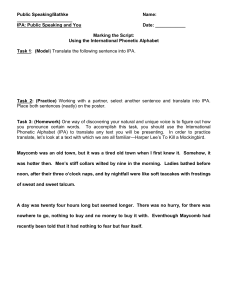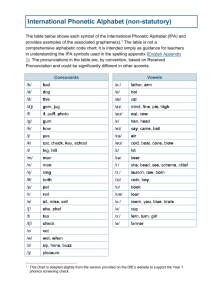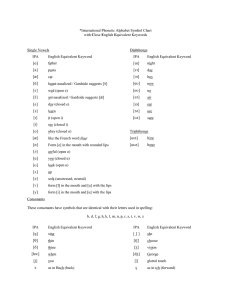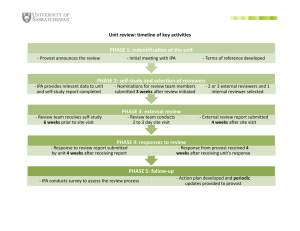An intermediate power amplifier upgrade for 40 to 80 Mhz
advertisement
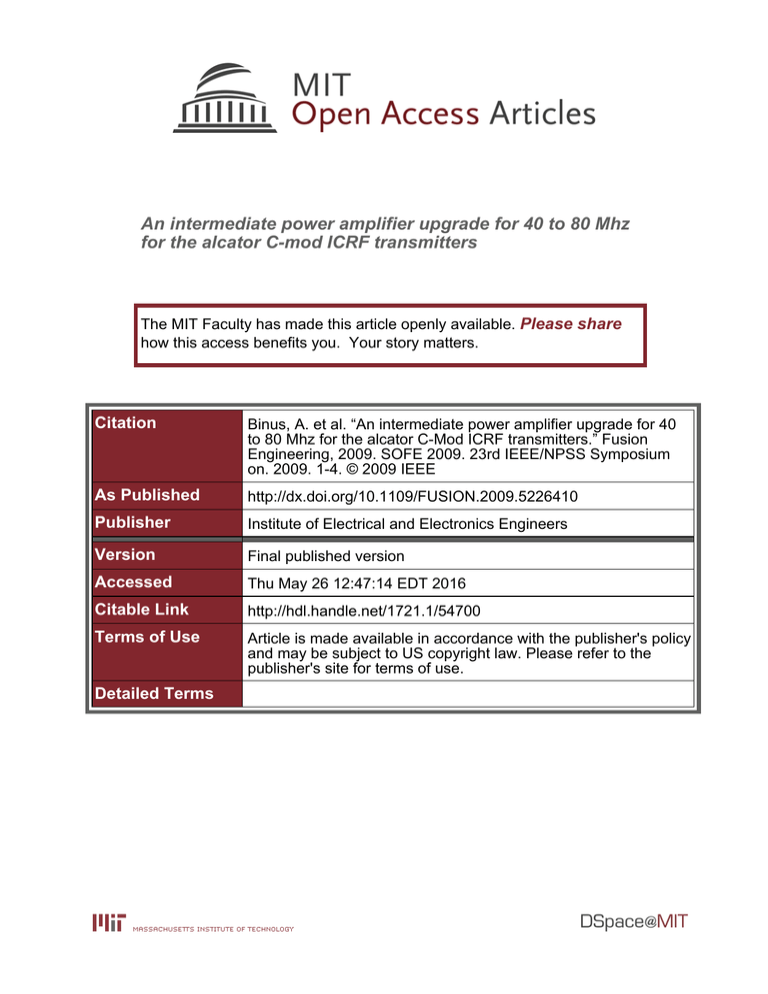
An intermediate power amplifier upgrade for 40 to 80 Mhz for the alcator C-mod ICRF transmitters The MIT Faculty has made this article openly available. Please share how this access benefits you. Your story matters. Citation Binus, A. et al. “An intermediate power amplifier upgrade for 40 to 80 Mhz for the alcator C-Mod ICRF transmitters.” Fusion Engineering, 2009. SOFE 2009. 23rd IEEE/NPSS Symposium on. 2009. 1-4. © 2009 IEEE As Published http://dx.doi.org/10.1109/FUSION.2009.5226410 Publisher Institute of Electrical and Electronics Engineers Version Final published version Accessed Thu May 26 12:47:14 EDT 2016 Citable Link http://hdl.handle.net/1721.1/54700 Terms of Use Article is made available in accordance with the publisher's policy and may be subject to US copyright law. Please refer to the publisher's site for terms of use. Detailed Terms An Intermediate Power Amplifier Upgrade for 40 to 80 Mhz for the Alcator C-Mod ICRF transmitters. A. Binus, S.J. Wukitch, Y. Lin, R. Murray, A. Pfeiffer Plasma Science and Fusion Center Massachusetts Institute of Technology Cambridge, MA, USA binus@psfc.mit.edu Abstract—ICRF operations with Alcator C-Mod consists of 4 transmitters, of which two are tunable within the 40 MHz to 80 MHz band. These transmitters were comprised of 3 stages all of which employed vacuum tube amplifiers. As a part of the general plan to upgrade the two tunable transmitters, a project was implemented to replace the first stage, the intermediate power amplifier, with a 10 kilowatt solid state broadband amplifier. There were two primary benefits from the upgrade. The tuning of the transmitters was considerably simplified and better performance was obtained under a variety of operational conditions by having a conservative power margin. The improvements obtained are an important first step toward advancing the overall radio frequency performance of the transmitters and minimizing the time intensive task of changing the frequency of operation. I. this stage had remained unchanged while the rest of the transmitter had been improved for greater power output. The overall arrangement up to this point is shown in Figure 1. A 500 watt exciter was required to achieve full performance of the 5kW triode. The modulator and control circuitry was able to deliver a signal on the order of 0 dbm, requiring the exciter to have considerable gain. INTRODUCTION Alcator C-Mod Ion Cyclotron Radio Frequency (ICRF) operations are constantly being evaluated in order to improve all aspects of the management of the transmitting systems. Every improvement made which simplifies the retuning, improves the quality or output level of the transmitters, and reduces the time required to set up for new operations, translates into better experimentation. The two tunable ICRF transmitters are particularly challenging because they are required to cover a range between 40 MHz and 80MHz. Prior to the upgrade described in this paper, the intermediate power amplifier (IPA), Driver and Final Power Amplifier (FPA), required retuning for each frequency change. The tuning process is compounded by the fact that the amplifier stages interact with one another, which necessitates an iterative process to completely tune the transmitter. This process can be shortened by replacing at least one tuned stage with a broadband solid state amplifier and, at the same time, some performance benefits can be realized. II. D. Gwinn Bagley Associates Lowell, MA gwinn@psfc.mit.edu FIGURE 1. ORIGINAL TRANSMITTER CONFIGURATION The project described here involved the removal of the 5 kW IPA and its replacement with a solid state, broadband, 10 kW amplifier that would require no more than +10 dbm of external excitation. The general reconfiguration as shown in Figure 2 required changes within the transmitter and impacted the components required to drive it. BACKGROUND The ICRF transmitters in use on C-Mod have a history of modifications. The FPA and Driver stages were both modified to upgrade the overall power. However, the IPA stage was still being driven by a nominal 5 kW water cooled triode and FIGURE 2. SOLID STATE IPA CONFIGURATION Work is supported by U.S. Department of Energy, Cooperative Grant No. DE-FC02-99ER54512-C-Mod 978-1-4244-2636-2/09/$25.00 ©2009 IEEE Authorized licensed use limited to: MIT Libraries. Downloaded on April 05,2010 at 13:47:44 EDT from IEEE Xplore. Restrictions apply. III. CHALLENGES TO THE UPGRADE A. High Q Matching Integrating a solid state broadband amplifier to drive an existing stage containing a tuned circuit and matching network can pose some difficulty. There are examples of successful upgrades and the issues and techniques used to resolve them are specific to the equipment and the way it is being used [1]. One concern was the potential for instability in driving a very high Q tuned structure. In the case of the Alcator C-Mod operation, initially it did not appear that this would be a problem because the Driver input tuning is rather broad. Later on, it was necessary to take another look at the matching issue. It was noted that during the very beginning of the test pulse that some irregularity was present. Figure 3 illustrates this condition. Whether this behavior is specifically due to the solid state IPA is not clear, but its extent does not appear to be excessive. B. Signal Compression Signal overload and compression considerations are always an inherent part of replacing one amplifier with another and this is particularly true in this case. There is always an optimal drive point for any amplifier. The amount of available power and the amplifier’s performance limits were evaluated to make certain that the new IPA would not be driven near the 1 db compression point. power is applied to the solid state amplifiers. Any type of fault in the solid state IPA generates a single latching IPA overload. The specifics of the IPA faults are not currently saved and those particular faults are self-resetting, though the IPA overload requires a manual reset. The solid state IPA modules require two substantial 50 volt high current power supplies. Power supply faults are reported through a single port via the IPA fault summary. Most are self resetting except for the over voltage protection which requires a special reset mechanism. For that reason, a remote reset has been postponed. The over voltage protection (OVP) has been set at a 2 volt margin with no observable false trips. E. Status Tracking The IPA status is tightly integrated into the power up sequence. Unless the IPA and the DC power are ready, high voltage will not be applied. The IPA modules report their ready status via the former IPA high voltage prove circuitry and the screen voltages of the final power amplifier and driver are prevented from being applied if there is anything wrong with the solid state IPA system. The circuit that previously detected the IPA filament voltage has been converted to report when the IPA power supplies have 480 VAC present and their background control systems are live. The high voltage activation sequence enables the power supply outputs which subsequently cause the solid state IPA modules to announce the presence of 48 VDC input power. F. IPA/Driver Interconnection C. Power Requirements The solid state IPA can produce twice the output power of the triode stage which it replaced and it has a lower efficiency. Although the removal of the vacuum tube stage reduced the AC power consumption due to the filament and anode power supplies, the recovered capacity was not enough to meet the 30 kW of AC power demanded by the solid state replacement. A separate 480 V, three phase circuit was added to the transmitter to serve the IPA power supplies. D. Protection Due to the replacement of the IPA triode and the elimination of its associated power supplies, some overloads needed to be re-assigned. The IPA anode overload was replaced by a summary fault that is the aggregate of all IPA alarms. Signals that identify problems like amplifier mismatch, excessive pulse length, over-temperature and 48 volt power supply failure will disable the transmitter high voltage . The solid state IPA modules’ faults are summed via control circuitry routed through a connector on the power combiner. They are momentarily masked by a secondary fault inhibitor, which is slaved to the original overload hold-off timer in the transmitter. This prevents any spurious overloads when DC The original IPA amplifier was linked to the Driver input via a Teflon dielectric coaxial cable. The connectors used to make this interconnection were not commonly available. Although the old cable was able to handle the original 5 kW peak power, a decision was made to convert the input of the Driver stage to a more universal RF connector. Moreover, the older cable type had been dropped by most coaxial cable manufacturers. In an emergency, a suitable replacement might be difficult to obtain. The output of the solid state IPA power combiner was provided with a type LC connector. Readily available adapters made it easy to transition this to an EIA 15/8 inch flange. This was mated with 1-5/8 inch semi rigid coaxial cable that was perfectly compatible with the interstage directional coupler’s EIA flanges. The input to the Driver stage was reconstructed with a 1-5/8 inch EIA flange. Custom brass and copper components were designed and fabricated to carry this all the way through to the contact point on the Driver input cavity. A fractional db improvement in losses was achieved and the testing and diagnostic procedures were conducted using commonly available RF adapters. The semi-rigid coaxial cable with its total copper outer conductor provided excellent isolation of the IPA output to minimize the possibility of the output RF from reaching the amplifiers own input. Authorized licensed use limited to: MIT Libraries. Downloaded on April 05,2010 at 13:47:44 EDT from IEEE Xplore. Restrictions apply. G. Signal input level The configuration with the tube type IPA required considerable excitation. An external broadband 500 Watt RF amplifier was needed to develop sufficient drive from the modulator’s 0 dbm output. Due to the considerable signal input sensitivity of the solid state IPA modules, a +10 dbm signal now drives the IPA to full output . This is temporarily being provided by a small wideband amplifier but a new set of modulators currently under construction will incorporate this additional gain in its design [2]. FIGURE 3. IPA VSWR AT FULL DRIVER POWER : F=78 MHZ IV. TUNING. An obvious advantage to the broadband IPA stage is the elimination of four adjustments that would normally be required in a tuned amplifier. In this case the input loading is only adjustable by mechanical disassembly. However the input tuning, output tuning and output loading associated with tuned amplifiers are not needed with the solid state IPA. Considerable work is avoided since tuning of this type of transmitter is an iterative process due to the degree of interstage adjustment dependency. V. PERFORMANCE The solid state IPA modules are broadband and run class AB which is not very efficient but the overall performance in terms of harmonics is perhaps better than the triode vacuum tube of the original IPA since it can operate very conservatively due to its higher output. The surplus of power also provides a hedge against the possible need for greater grid drive, if the Drivers are updated at a later time to a more powerful tube. The match between the IPA and Driver is, in general, quite good. However, as mentioned previously in this paper, there is a 1.6 millisecond interval at the very beginning of the pulse what exhibits a very high VSWR. Figure 3 demonstrates this issue. The reason for this is unknown but it has been identified in both transmitters. Figure 4 is the Driver power output associated with the VSWR in Figure 3. It is not known whether this is due to the Driver input Q or some other cause. It is only known that it is a transient behavior. MW seconds FIGURE 4. DRIVER POWER OUT : F=78 MHZ VI. CONCLUSIONS With a reasonable degree of caution the legacy 5 kW triode based IPA stage in the Alcator C-Mod ICRF transmitters can be replaced with a broadband solid state amplifier. The quality of matching between the IPA and the driver stage was good and not difficult to achieve in the tuning process from 40 to 80 MHz. The increase in power reserve allowed operation of the IPA at levels that were well below the 1 db compression point and it provided a stable 50 ohm source for the driver input. There are some anomalies regarding the match during the first millisecond of the RF pulse and this warrants further investigation and more analysis of the Driver input cavity [3]. REFERENCES Authorized licensed use limited to: MIT Libraries. Downloaded on April 05,2010 at 13:47:44 EDT from IEEE Xplore. Restrictions apply. [1] [2] [3] J.T.M Lyles and C. C. Friedrichs, Jr.,LANCE 201,25 MHz Drift Tube LINAC RF POWER STATUS”, LINAC96 Proceedings, THP22, Geneva Switzerland, 1996 R.A. Murray, “Upgrade of the ICRF Fault and Control Systems on Alcator C-Mod.”, unpublished. C. Brunkhorst,, “RF Cavity Analysis with Spreadsheet Software”, 17th IEEE/NPSS Symposium, San Diego, CA, Fusion Engineering, p. 448-451, vol. 1., 1997. Authorized licensed use limited to: MIT Libraries. Downloaded on April 05,2010 at 13:47:44 EDT from IEEE Xplore. Restrictions apply.
